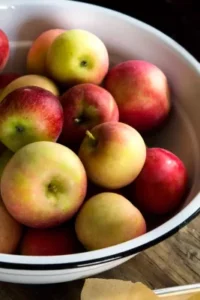
When assessing how different materials may affect the environment, biodegradability is an important factor to take into account. It describes a substance’s capacity to degrade spontaneously and return to the environment without damage. Fruit peels’ biodegradability is affected by a number of factors, including
A chemical is biodegradable when it can be broken down into simpler components naturally by microbes like bacteria and fungi. Without leaving behind toxic leftovers, these substances can then be used by other species or absorbed back into the environment.
What Does Biodegradable Mean?
Biodegradability refers to the ability of a substance to be broken down naturally by biological processes, such as the action of microorganisms, into simpler compounds and ultimately into harmless substances like water, carbon dioxide, and biomass. When a material is biodegradable, it can undergo decomposition and return to the environment without leaving behind persistent pollutants or causing long-term environmental harm.
In the context of fruit peels, understanding the biodegradability of these organic waste products is crucial for assessing their impact on the environment and exploring sustainable waste management solutions.
Are Fruit Peels Biodegradable?
Yes, fruit peels are biodegradable. They normally break down over time through the action of microbes, releasing nutrients back into the atmosphere. Proper disposal methods, such as composting, can ensure their effective biodegradation and minimize their environmental effect.
Also Read: Are Banana peels Biodegradable?
The Composition of Fruit Peels
Fruit peels are natural byproducts of fruits, encompassing the outer layers that are typically removed and discarded during consumption. These peels are primarily composed of organic materials, such as cellulose, hemicellulose, lignin, pectin, and various plant pigments. These organic compounds contribute to the nutritional value, taste, and color of fruits.
Unlike synthetic materials, which are manufactured through chemical processes using non-renewable resources, fruit peels are derived from plants and are considered organic matter. They are rich in complex organic compounds that can be broken down by microorganisms through natural processes.
It’s important to note that while fruit peels are organic, their biodegradability may vary depending on factors such as their thickness, chemical composition, and the environmental conditions in which they are disposed of or managed.
Understanding the composition of fruit peels helps us recognize their potential as a renewable resource and assess their environmental impact when disposed of or processed in different ways. By promoting the proper disposal and utilization of fruit peels, we can harness their biodegradable nature to minimize waste and contribute to a more sustainable future.
Factors Affecting the Biodegradability of Fruit Peels
The biodegradability of fruit peels is influenced by various factors that can impact the rate and effectiveness of their decomposition. Understanding these factors is crucial for implementing appropriate waste management strategies and maximizing the environmental benefits of fruit peel disposal. Here are some key factors that affect the biodegradability of fruit peels:
- Chemical Composition: The chemical composition of fruit peels plays a significant role in their biodegradability. Peels rich in organic compounds like cellulose, hemicellulose, and pectin tend to be more easily broken down by microorganisms, promoting faster decomposition.
- Thickness and Surface Area: Thicker fruit peels take longer to decompose compared to thinner ones due to the increased resistance to microbial attack. Moreover, the surface area of the peel affects the exposure of the organic matter to microorganisms. Finely chopped or shredded peels provide a larger surface area for microbial action, accelerating biodegradation.
- Moisture Content: Adequate moisture is essential for microbial activity during decomposition. Dry fruit peels may decompose slowly or remain intact for longer periods. Optimal moisture levels facilitate the growth and activity of microorganisms responsible for breaking down the organic matter.
- Oxygen Availability: Microorganisms involved in the biodegradation process are classified as aerobic or anaerobic, depending on their oxygen requirements. Fruit peels exposed to oxygen-rich environments (aerobic conditions) facilitate the activity of aerobic microorganisms, leading to faster decomposition. In anaerobic conditions with limited oxygen, the decomposition process may be slower.
- Temperature: Higher temperatures generally enhance microbial activity and accelerate decomposition. Warmer climates or controlled composting systems provide favorable conditions for microorganisms to efficiently break down fruit peels. Cold temperatures can slow down the decomposition process.
Also Read: How Long does It Takes Banana Peels to Decompose?
The Role of Microorganisms in Fruit Peel Decomposition
Microorganisms play a vital role in the decomposition of fruit peels. Bacteria and fungi are the primary decomposers responsible for breaking down organic matter into simpler compounds. Here’s how microorganisms contribute to fruit peel decomposition:
Enzyme Production: Microorganisms produce enzymes that help break down complex organic compounds present in fruit peels into smaller molecules. These enzymes, such as cellulases and pectinases, target specific components of the peels and initiate their degradation.
Nutrient Recycling: During the decomposition process, microorganisms utilize the nutrients present in fruit peels as a food source. They metabolize the organic matter, releasing byproducts, such as carbon dioxide and water, and converting the remaining nutrients into forms that can be utilized by other organisms and plants.
Microbial Communities: Fruit peel decomposition involves complex microbial communities consisting of diverse bacteria and fungi. Different species of microorganisms work synergistically, each contributing their unique set of enzymes and metabolic capabilities, to efficiently break down the organic matter.
Feedback Loop: As microorganisms decompose fruit peels, they release organic matter breakdown products and waste materials. These byproducts can act as nutrients for other microorganisms or plants, creating a feedback loop in the ecosystem that sustains the decomposition process and contributes to soil fertility.
Understanding the role of microorganisms in fruit peel decomposition highlights the importance of providing favorable conditions for their activity. Proper waste management practices, such as composting, can promote the growth of beneficial microorganisms and facilitate the efficient biodegradation of fruit peels, minimizing waste and supporting a more sustainable environment.
Fruit Peels as a Potential Source of Nutrients for the Environment
Fruit peels, often considered as waste or discarded material, have the potential to serve as a valuable source of nutrients for the environment. These peels contain a variety of organic compounds that can contribute to soil fertility, promote plant growth, and support ecosystem health. Here are some ways in which fruit peels can be utilized as a nutrient resource:
- Composting: Fruit peels can be composted along with other organic waste materials to create nutrient-rich compost. Composting is a natural process in which microorganisms break down organic matter, including fruit peels, into a nutrient-rich soil amendment known as compost. This compost can be used as a fertilizer to enhance soil quality, improve moisture retention, and provide essential nutrients to plants.
- Soil Amendment: Directly incorporating fruit peels into the soil can enhance its nutrient content. The organic matter in the peels decomposes over time, releasing nutrients such as nitrogen, phosphorus, potassium, and trace elements into the soil. These nutrients are essential for plant growth and can improve soil structure, water-holding capacity, and microbial activity.
- Vermicomposting: Fruit peels can be fed to composting worms, such as red wigglers, in a process called vermicomposting. The worms consume the peels, and their digestive processes help break down the organic matter and produce nutrient-rich worm castings, also known as vermicompost. Vermicompost is highly valuable as a soil amendment due to its increased nutrient availability and beneficial microorganism content.
- Natural Fertilizers: Extracts or solutions can be derived from fruit peels through various techniques, such as fermentation or soaking. These extracts can be diluted and used as natural fertilizers to provide nutrients and stimulate plant growth. The extracts may contain compounds that promote root development, improve soil microbial activity, and enhance plant resistance to diseases.
By harnessing the nutrient content of fruit peels, we can reduce waste, conserve resources, and support sustainable agricultural practices. However, it’s important to note that the suitability of fruit peels as a nutrient source may vary depending on their specific composition, processing methods, and application techniques. Proper composting techniques, vermicomposting practices, and responsible use of fruit peel extracts are essential to maximize their potential as a nutrient resource while minimizing environmental impacts.
Also Read: Can Chickens Eat Banana peels?
Comparing the Biodegradability of Different Fruit Peels
The biodegradability of fruit peels can vary depending on several factors, including their chemical composition, structural characteristics, and environmental conditions. Comparing the biodegradability of different fruit peels provides insights into their decomposition rates and potential environmental impacts. Here are some factors to consider when comparing the biodegradability of different fruit peels:
- Cellulose and Hemicellulose Content: Fruit peels rich in cellulose and hemicellulose, which are complex carbohydrates, tend to be more easily biodegradable. These compounds serve as a food source for microorganisms involved in decomposition processes.
- Lignin Content: Lignin is a complex polymer that provides structural support to plant cells. Fruit peels with higher lignin content may decompose more slowly as lignin is resistant to microbial breakdown. Peels with lower lignin content are typically more biodegradable.
- Chemical Treatments: Some fruits may undergo chemical treatments, such as wax coatings or preservatives, to enhance shelf life and appearance. These treatments can affect the biodegradability of the fruit peels, as they may introduce synthetic compounds that are not easily broken down by natural processes.
- Environmental Conditions: The rate of biodegradation can be influenced by environmental factors such as temperature, moisture, and oxygen availability.
Environmental Impacts of Non-Biodegradable Fruit Peel Waste
The improper disposal of non-biodegradable fruit peel waste can have detrimental effects on the environment. When fruit peels end up in landfills or are discarded inappropriately, they contribute to various environmental issues. Here are some key environmental impacts associated with non-biodegradable fruit peel waste:
- Landfill Space: Non-biodegradable fruit peels occupy valuable landfill space. As landfills reach their capacity, the need for additional land for waste disposal increases, leading to deforestation or encroachment on natural habitats.
- Methane Emissions: Fruit peels in landfills undergo anaerobic decomposition, producing methane gas—a potent greenhouse gas. Methane contributes to climate change and global warming, exacerbating environmental challenges.
- Soil and Water Pollution: When non-biodegradable fruit peels are disposed of inappropriately, they can contaminate soils and water bodies. Harmful chemicals or synthetic materials present in some fruit peels can leach into the soil, polluting groundwater and affecting the health of plants, animals, and humans.
- Wildlife and Marine Life Impacts: Improper disposal of non-biodegradable fruit peel waste can harm wildlife and marine life. Animals may mistake fruit peels for food, leading to ingestion or entanglement, which can have adverse effects on their health and survival. Marine ecosystems can be negatively impacted by fruit peel waste entering water bodies, causing habitat degradation and disrupting the balance of marine ecosystems.
Also Read: Can You Smoke Plantain Leaves
Sustainable Solutions: Composting and Recycling Fruit Peels
Implementing sustainable waste management practices is crucial to minimize the environmental impacts of fruit peel waste. Here are two sustainable solutions for fruit peel disposal:
Composting: Composting fruit peels is an effective and environmentally friendly way to manage organic waste. Through composting, fruit peels can be transformed into nutrient-rich compost, which can be used as a natural fertilizer for plants and soil. Home composting or community composting initiatives can divert fruit peels from landfills, reduce greenhouse gas emissions, and enrich the soil with valuable nutrients.
Recycling and Industrial Processes: In certain cases, fruit peels can be recycled or processed through industrial methods. For example, some fruit peels can be used to extract natural dyes or pigments for textile or paper production. Industrial processes may also convert fruit peels into biofuels or other valuable bio-based products, reducing waste and utilizing their potential.
By embracing sustainable solutions and incorporating fruit peels into circular economy practices, we can not only reduce waste but also harness their potential as valuable resources, minimizing environmental impacts and moving towards a more sustainable future.
Innovative Approaches: Utilizing Fruit Peels in Biofuel Production
Fruit peels, which are often considered waste, can be utilized in innovative ways, such as biofuel production. Biofuels are renewable energy sources derived from organic materials, including fruit peels. Here are some key aspects of utilizing fruit peels in biofuel production:
Biochemical Conversion: Fruit peels contain complex organic compounds, such as carbohydrates and lignocellulosic materials, which can be converted into biofuels through biochemical processes. Techniques like fermentation and enzymatic hydrolysis break down the organic matter in fruit peels to produce bioethanol, a biofuel that can be used as a renewable alternative to fossil fuels.
Research and Technological Advancements: Ongoing research and technological advancements are continuously improving the efficiency and feasibility of utilizing fruit peels in biofuel production. Scientists are exploring innovative pretreatment methods, enzyme engineering, and microbial optimization to enhance the conversion of fruit peel biomass into biofuels.
Promoting Awareness: Encouraging Responsible Fruit Peel Disposal
Raising awareness about responsible fruit peel disposal is crucial to foster sustainable waste management practices. Here are some strategies to promote responsible fruit peel disposal:
Education and Information: Educate individuals, communities, and businesses about the environmental impact of fruit peel waste and the importance of responsible disposal. Provide information on composting, recycling, and other sustainable options available for fruit peels.
Community Composting Initiatives: Encourage the establishment of community composting programs or initiatives where residents can collectively compost their fruit peels and other organic waste. These programs can provide composting infrastructure, training, and support to community members.
By encouraging responsible fruit peel disposal practices and promoting innovative approaches to utilize fruit peels, we can minimize waste, reduce environmental impact, and unlock the potential of fruit peels as valuable resources in biofuel production and other sustainable applications.





